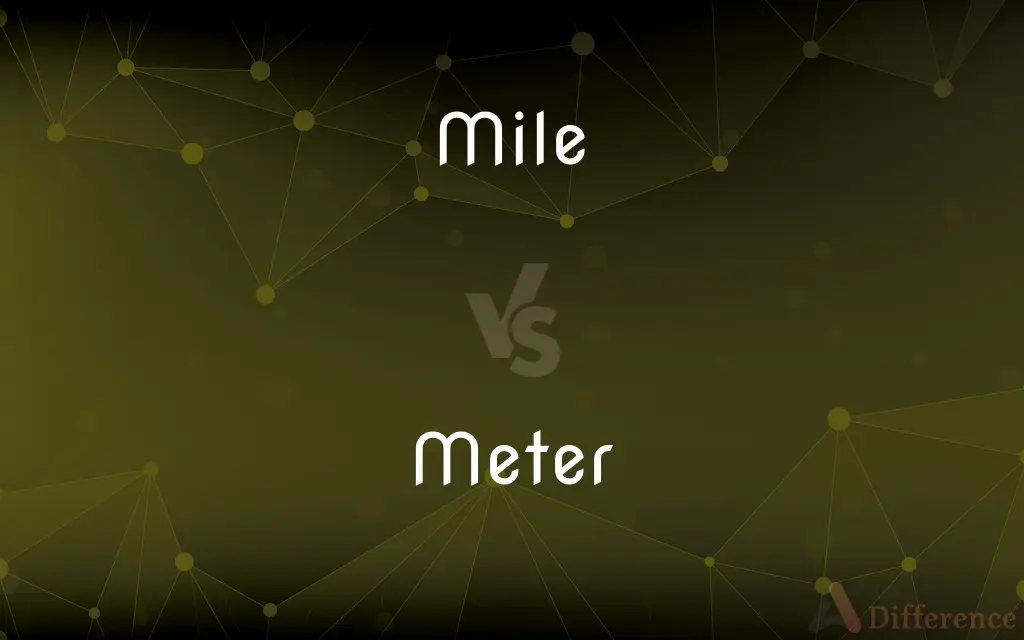Mile vs. Meter — What's the Difference?
By Fiza Rafique & Urooj Arif — Updated on April 3, 2024
A mile is a unit of distance primarily used in the United States, equal to 5,280 feet or about 1,609 meters, while a meter is the base unit of length in the International System of Units (SI), equal to 100 centimeters.

Difference Between Mile and Meter
Table of Contents
ADVERTISEMENT
Key Differences
A mile is a longer unit of measurement used predominantly in the United States for measuring distances, especially in road distances and sports. It's equivalent to 5,280 feet or approximately 1,609 meters. This unit is part of the imperial system of measurements, which includes yards, feet, and inches. On the other hand, a meter is the standard unit of length in the metric system, widely used around the world for all types of measurements. One meter is defined as the distance light travels in vacuum in 1/299,792,458 of a second, providing a universal physical basis for the unit.
Miles are commonly used in countries that have not fully adopted the metric system, like the United States and the United Kingdom for specific applications. This makes understanding and converting miles important in these regions, especially for international travelers and in international contexts. Whereas meters are universally recognized and used for scientific, engineering, and everyday measurements in most parts of the world, facilitating international collaboration and standardization.
In terms of scale, miles are used to measure longer distances such as the length of a road or the distance between cities, reflecting larger spatial relationships. Meters, being a base unit of length, are used to measure both small and large distances but are more commonly associated with measurements within human scale, such as the height of a person or the length of a room.
When converting between these units, the specific conversion factor of 1 mile equals approximately 1,609.34 meters is used. This conversion is crucial for activities like running, where races might be measured in kilometers in one country and miles in another, necessitating a clear understanding of both units for accurate comparison and training.
Despite their differences, both units are essential for navigation, science, and daily life, each fitting into a broader system of measurement that caters to different historical, cultural, and practical needs. The mile, with its origins in the Roman mille passus, or "thousand paces," carries with it centuries of history, while the meter, established during the French Revolution, embodies the principles of universality and scientific precision.
ADVERTISEMENT
Comparison Chart
System
Imperial
Metric
Unit Type
Distance
Length
Usage
Primarily in the US for roads, sports
Worldwide for scientific, everyday use
Equivalent
5,280 feet, approximately 1,609 meters
100 centimeters
Basis
Historical and customary
Physical constant (speed of light)
Scale
Longer distances
Both small and large distances
Conversion Factor
1 mile = 1,609.34 meters
1 meter = 0.000621371 miles
Origin
Roman mille passus ("thousand paces")
French Revolution, for standardization
Representation
Used in countries not fully metric
Universal unit of length
Compare with Definitions
Mile
Historical unit of length.
Ancient Roman roads were measured in miles.
Meter
Base SI unit of length.
The table is 2 meters wide.
Mile
Road distance in the US and UK.
The next town is 5 miles away.
Meter
Everyday measurements.
He is 1.75 meters tall.
Mile
Sporting events distances.
He runs the mile in under 4 minutes.
Meter
International standard.
Olympic swimming pools are 50 meters long.
Mile
Long distance measurement.
The marathon is 26.2 miles long.
Meter
Engineering and construction.
The bridge spans 500 meters.
Mile
Used in aviation and nautical.
The flight covered 600 nautical miles.
Meter
Used in scientific measurements.
Light travels at 299,792,458 meters per second.
Mile
The mile, sometimes the international mile or statute mile to distinguish it from other miles, is a British imperial unit and US customary unit of distance; both are based on the older English unit of length equal to 5,280 English feet, or 1,760 yards. The statute mile was standardised between the British Commonwealth and the United States by the international agreement in 1959, when it was formally redefined with respect to SI units as exactly 1,609.344 metres.
Meter
The measured arrangement of words in poetry, as by accentual rhythm, syllabic quantity, or the number of syllables in a line.
Mile
A unit of linear measure equal to 1,760 yards (approximately 1.609 kilometres).
Meter
A particular arrangement of words in poetry, such as iambic pentameter, determined by the kind and number of metrical units in a line.
Mile
A very long way or a very great amount
Vistas which stretch for miles
This is my favourite film by a mile
Meter
The rhythmic pattern of a stanza, determined by the kind and number of lines.
Mile
By a great amount or a long way
The second tape is miles better
Meter
Division into measures or bars.
Mile
Abbr. mi. or mi A unit of length equal to 5,280 feet or 1,760 yards (1,609 meters), used in the United States and other English-speaking countries. Also called land mile, statute mile. See Table at measurement.
Meter
A specific rhythm determined by the number of beats and the time value assigned to each note in a measure.
Mile
A nautical mile.
Meter
The international standard unit of length, approximately equivalent to 39.37 inches. It was redefined in 1983 as the distance traveled by light in a vacuum in 1/299,792,458 of a second. See Table at measurement.
Mile
An air mile.
Meter
Any of various devices designed to measure time, distance, speed, or intensity or indicate and record or regulate the amount or volume, as of the flow of a gas or an electric current.
Mile
(Sports) A race that is one mile long.
Meter
A postage meter.
Mile
A relatively great distance
Had to walk for miles in the airport.
Meter
A parking meter.
Mile
The international mile: a unit of length precisely equal to 1.609344 kilometers established by treaty among Anglophone nations in 1959, divided into 5,280 feet or 1,760 yards.
Turn left in 1.2 miles.
Meter
To measure with a meter
Meter a flow of water.
Mile
Any of several customary units of length derived from the 1593 English statute mile of 8 furlongs, equivalent to 5,280 feet or 1,760 yards of various precise values.
Meter
To supply in a measured or regulated amount
Metered the allotted gasoline to each vehicle.
Mile
Any of many customary units of length derived from the Roman mile (mille passus) of 8 stades or 5,000 Roman feet.
Meter
To imprint with postage or other revenue stamps by means of a postage meter or similar device
Metering bulk mail.
Mile
The Scandinavian mile: a unit of length precisely equal to 10 kilometers defined in 1889.
Meter
To provide with a parking meter or parking meters
Meter parking spaces.
Mile
Any of many customary units of length from other measurement systems of roughly similar values, as the Chinese (里) or Arabic mile (al-mīl).
Meter
A device that measures things.
Mile
(travel) An airline mile in a frequent flyer program.
Meter
A parking meter or similar device for collecting payment.
Gas meter
Mile
(informal) Any similarly large distance.
The shot missed by a mile.
Meter
One who metes or measures.
A labouring coal-meter
Mile
(slang) A race of 1 mile's length; a race of around 1 mile's length (usually 1500 or 1600 meters)
The runners competed in the mile.
Meter
(American spelling) The base unit of length in the International System of Units (SI), conceived as 1/10,000,000 of the distance from the North Pole to the Equator, and now defined as the distance light will travel in a vacuum in 1/299,792,458 seconds.
Mile
(slang) One mile per hour, as a measure of speed.
Five miles over the speed limit
Meter
(American spelling) The overall rhythm of a song or poem; particularly, the number of beats in a measure or syllables in a line.
Mile
A certain measure of distance, being equivalent in England and the United States to 320 poles or rods, or 5,280 feet.
Meter
(obsolete) A poem.
Mile
A unit of length equal to 1760 yards
Meter
(American spelling) A line above or below a hanging net, to which the net is attached in order to strengthen it.
Mile
A unit of length used in navigation; equivalent to the distance spanned by one minute of arc in latitude; 1,852 meters
Meter
To measure with a metering device.
Mile
A large distance;
He missed by a mile
Meter
To imprint a postage mark with a postage meter.
Mile
A former British unit of length once used in navigation; equivalent to 1828.8 meters (6000 feet)
Meter
To regulate the flow of or to deliver in regulated amounts (usually of fluids but sometimes of other things such as anticipation or breath).
Mile
A British unit of length equivalent to 1,853.18 meters (6,082 feet)
Meter
One who, or that which, metes or measures. See Coal-meter.
Mile
An ancient Roman unit of length equivalent to 1620 yards
Meter
An instrument for measuring, and usually for recording automatically, the quantity measured.
Mile
A Swedish unit of length equivalent to 10 km
Meter
A line above or below a hanging net, to which the net is attached in order to strengthen it.
Mile
A footrace extending one mile;
He holds the record in the mile
Meter
Rhythmical arrangement of syllables or words into verses, stanzas, strophes, etc.; poetical measure, depending on number, quantity, and accent of syllables; rhythm; measure; verse; also, any specific rhythmical arrangements; as, the Horatian meters; a dactylic meter.
The only strict antithesis to prose is meter.
Meter
A poem.
Meter
A measure of length, equal to 39.37 English inches, the standard of linear measure in the metric system of weights and measures. It was intended to be, and is very nearly, the ten millionth part of the distance from the equator to the north pole, as ascertained by actual measurement of an arc of a meridian. See Metric system, under Metric.
Meter
The basic unit of length adopted under the Systeme International d'Unites (approximately 1.094 yards)
Meter
Any of various measuring instruments for measuring a quantity
Meter
(prosody) the accent in a metrical foot of verse
Meter
Rhythm as given by division into parts of equal time
Meter
Measure with a meter;
Meter the flow of water
Meter
Stamp with a meter indicating the postage;
Meter the mail
Common Curiosities
Can you convert meters to miles easily?
Yes, by using the conversion factor, 1 meter = 0.000621371 miles.
How did the meter get its definition?
The meter was originally intended to be one ten-millionth of the distance from the equator to the North Pole along a meridian through Paris, but it is now defined by the distance light travels in a vacuum in 1/299,792,458 seconds.
Why is the meter considered a universal unit?
The meter is the base unit of length in the International System of Units (SI), adopted worldwide for its scientific precision and universal definition.
Is there a difference between a statute mile and a nautical mile?
Yes, a statute mile is 5,280 feet, used on land, while a nautical mile, used in maritime and aviation, is longer, approximately 1,852 meters.
How are meters used in everyday life?
Meters are used in everyday measurements around the world, from personal height to the size of rooms and gardens.
Are all sports measured in meters?
While many international sports use meters for measurement, some, especially in the US, still use miles or yards.
What is a mile used for besides measuring distance?
Besides distance, miles are used in calculating speed, such as miles per hour (mph), in countries not fully metric.
Why is the mile used in the US instead of the meter?
The mile is part of the customary system of measurements historically used in the US, which has not fully adopted the metric system.
How many meters are in a mile?
One mile is approximately 1,609.34 meters.
What are the benefits of using the metric system and meters?
The metric system is decimal-based, making calculations simpler and standardization easier across different countries and fields.
Share Your Discovery

Previous Comparison
Left vs. Leaved
Next Comparison
Yesterday vs. TodayAuthor Spotlight
Written by
Fiza RafiqueFiza Rafique is a skilled content writer at AskDifference.com, where she meticulously refines and enhances written pieces. Drawing from her vast editorial expertise, Fiza ensures clarity, accuracy, and precision in every article. Passionate about language, she continually seeks to elevate the quality of content for readers worldwide.
Co-written by
Urooj ArifUrooj is a skilled content writer at Ask Difference, known for her exceptional ability to simplify complex topics into engaging and informative content. With a passion for research and a flair for clear, concise writing, she consistently delivers articles that resonate with our diverse audience.















































